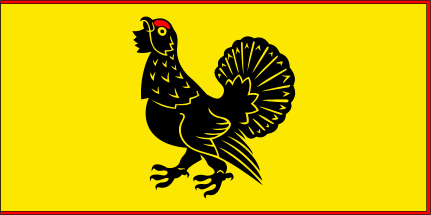
by Audrius Slapsinskas, 24 June 2003

Last modified: 2003-07-12 by dov gutterman
Keywords: lithuania | siauliai | bubiai | wood grouse |
Links: FOTW homepage |
search |
disclaimer and copyright |
write us |
mirrors

by Audrius Slapsinskas, 24 June 2003
See also:
The flag and coat of arms of Bubiai were drawn according to
pictures, which was taken from booklet: "DISTRICT OF
SIAULIAI AND ITS CONTEMPORARY HERALDRY" [lal02]. Here is information from this
booklet:
"Bubiai - In 1566 Bubiai was named as a settlement, although
archeological findings prove that it dates back to the 5-6 th
centuries. Dubysa (Dobitzen) castle, burned down in 1348 and 1358
by the Knights of the Sword, stood on Bubiai mound on the left
bank of the river Dubysa. Spearheads and arrowheads, knives,
keys, charred grains are among the findings of the 11 -14 th
century.
The sound produced by wood-grouses may have association with the
name of the settlement. Another version is that bogy men used to
live in the woods nearby.
In 1783 there were 13 households of 50 people. In 1825 building
works of the Dubysa-Venta cannal, which had to link the rivers
with the Baltic Sea, were started, however, were not completed by
1831.
Count Zubovas had a manor house there from the 18th to the
beginning of the 20th century. In 1899 a primary school was
founded, which later developed into a basic school. Dmitrijus
Zubovas was mainly engaged in cattle breeding, so in 1910 he
founded a 3 year agricultural school of cattle breeding and dairy
production which functioned until 1915. The Lithuanian language
was an oficial language of instruction in both schools. The
constructions of the farmstead have remained to the present days.
During the decades of Independence the number of the population
in Bubiai rose, a brick-yard, a saw-mill, a dairy, a school, a
post office and other institutions started working.
May Day festivals organised in Bubiai at the end of the 19th
century were part of the national revival movement, which led to
the national autonomy and independence.
Bubiai is situated 14 km south west from Siauliai. The number of
the population has increased from 259 in 1923 to 932 in 2002.
Since 1995 Bubiai has developed into the centre of the rural
municipality, which includes Bazilionai, Kurtuvenai and 110
villages with 3.900 inhabitants.
Bubiai is famous for Girnikai and Bubiai mounds, legends about
which are passed from generation to generation, and the beautiful
surrounding landscape. The church built in 1792 in Kurtuvenai and
some constructions of the manor are among the places of interest
and attraction. In 1998 one construction of the manor was
restored and presently houses the administration of the
Kurtuvenai Regional Park. Since 2001 International Outdoor
Theatre Festivals are being organised in Kurtuvenai.
Bubiai has never had its coat of arms. The Heraldry Commission
with the approval of the local community designed the coat of
arms for Bubiai: a black wood-grouse with a red head on a field
of gold (design by Rolandas Rimkunas). The Bubiai coat of arms
was confirmed by the President of the Republic of Lithuania on
March 23, 2000."
Audrius Slapsinskas, 24 June 2003
sasab.gif)
by Audrius Slapsinskas, 24 June 2003